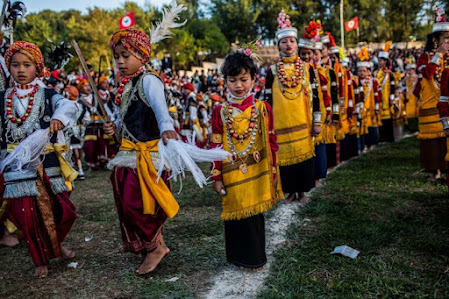THE EARTH'S PALETTE : NATURAL DYES OF NAGALAND - A LANGUISHING ART.
Fig 1: Source (www.artisanscentre.com)
India's expertise in natural dyes dates back to ancient times. Purple dye on a piece of cotton discovered from the Harappa and Mohenjo-Daro excavation, indicate that the art of dyeing was known and practised. (Punia, 2015). The Northeast region of India with 8 states and ethnic groups inhabiting the region, have indigenous knowledge system with distinctive methods of dyeing. Nagaland, a state in northeast India is home to diverse tribes and sub-tribes.The Nagas would grow their own cotton, hand-spun their own yarn and dyed the yarns using natural dyes. The Nagas continued natural dyeing until the 1920s. The dyeing traditions gradually disappeared after colored yarn from Burma (present day Myanmar) appeared and synthetic colors were available in Europe. (Tripathi.S, 2009).
Traditional natural dyeing is a languishing art in Nagaland and insufficient literature is available on the subject. Different tribes have knowledge of different dyes, while often some dyeing processes are uniquely known to only one tribe.
The article gathers information on traditional knowledge associated with the extraction and use of natural dyes among the Nagas. Primary study has been conducted by documenting and observing the dyeing process of the tribes and Interviews were conducted while observing the step by step process. This research assimilates traditional knowledge and hopes to contribute to the revival of this languishing craft.
Nagaland being rich in all kinds of flora is a rich source of natural dye. The tribes also have been very successful in exploring the rich flora here in terms natural dyes.
a) Red Dye : the red is obtained from a plant called Trenhyii, it is a creeper which grows and spreads on the ground. The creeper has thorns on it and the leaves have rough surfaces on both the sides. The maximum length of the Trenhyii leaf is 5”. Here, both stem and leaves are used for dyeing but only after the rough surface of the stem is removed. The darker and lighter shades are achieved through the concentration of the raw material depending on the amount of the raw material taken. In Zeliang tribe, the red colour is also obtained from a plant where the leaves are used for the dyeing purpose. These plants are not cultivated and they are usually collected from the jungle. It takes nearly 2 days to complete the procedure of dyeing. This procedure can be carried out at any time of the year. The stem and the leaves are first crushed then boiled with water and the yarn is then immersed untill it receives the desired colour.
Fig 3 : Acid berry; Rhus semialata (Source: treeflower.la.coocan.jp)
b) Yellow dye : The tones of yellow colour are basically obtained from a tree called Athua. The bark of this tree is called Puokha which is also used as a medicine to cure high blood pressure and other ailments problems. The taste of the bark of the Athua tree is bitter. Here, the stem of the tree is used for dyeing purpose. The stem is first crushed and then boiled with the water and once the water turns yellow, the yarns are soaked in it. Yellow colour is also obtained from a flowering tree called Temiiiphii. This tree flowers once a year. The flower does not fade away so soon like other flowers. Here, the buds can also be used for dyeing. But to achieve a better colour, it is important to use fully bloomed flowers for the dyeing purpose.
These trees also protect the houses from violent storms therefore; it was also grown in the village vicinity. The flowers along with the stalks are collected in bundles and the bunch is then pounded with the help of a pounding tool. The powdered flowers are then soaked in the water for 5-6 days. During this time the water turns yellow in colour and the residue also settles down at the bottom of the container. The obtained coloured liquid is used for dyeing.
c) Black dye : It is obtained from a plant called zophru; a 3-foot-tall shrub. Here both the leaves and stems are used for colouring. It is boiled and once the water turns black the raw material is added. For dyeing one shawl, the dyers take two handfuls of leaves along with the stems. During the older days the old faded black shawls or old white shawl were also re-dyed in this dye bath. For the Zeliang tribe, the black colour is obtained from the root (chakhiu) of a wild family of nut tree. ‘File nut is around 2.5 cm diameter and when the hard shell is broken there are a numbers of small nuts that tastes exactly like coconut. The root of this tree is used for dyeing purpose where the root is first powdered and then boiled with water to dye the raw material.






Comments
Post a Comment